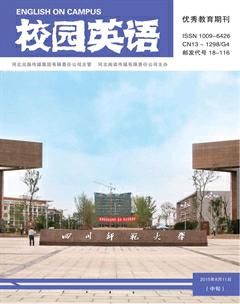A Review of CBI Foreign Language Teaching Research in China within Recent 20 Years
刘静
【Abstract】In this paper,we review the research on CBI(content—based instruction),a foreign language teaching approach,which was introduced into China 20 years ago.By analyzing the changing focus of researches on CBI and evaluating this approach to foreign language teaching,we hope shadow some light on better CBI-focused researches and we believe that it is possible and feasible to better apply CBI to foreign language teaching in China.
【Key words】foreign language teaching; CBI; review
1.Introduction
CBI has long been identified as a highly effective approach to both first and second language teaching(Brinton,Snow,&Wesche,2003).CBI has many variations,among which some of the most common models are TB(theme-based)courses,AL(“adjunct/linked”)courses,and SSM(sheltered subject-matter)courses.Despite of the variations among these models,CBI is a curricular approach that“seeks to develop proficiency in both the non—language subject and the language in which it is taught,attaching the same importance to each”.
2.Definition
What is CBI? Brinton,Snow,and Wesche (1989,p.vii)define CBI as,‘the concurrent study of language and subject matter,with the form and sequence of language presentation dictated by content material.Even though there are older examples of CBI,its origins are usually associated with Canadian immersion programs,which is the best-known example of CBI.CBI includes different types of immersion but also other programs.Stoller (2008,p.59)considers that CBI is ‘an umbrella term for approaches that combine language and content learning aims even if there are differences in the emphasis placed on language and content.Met (1998)provided ‘a continuum of content and language integration that ranges from the most content-driven end,which is total immersion followed by partial immersion to the most language-driven end.In all cases,the aims of the program combine the learning of curricular content and language learning.
3.Literature Review
Began in the 1960s,in Canada,content-based instruction was studied by Chinese scholar since 1990s,when Wang Shixian took the lead mediator in 1994 to introduce the basic concepts and original mode of CBI,discussing theoretically its possibility of application in Chinese language teaching.Since then,especially since 2001,there emerge researches about CBI in large numbers,most of which are about theoretical exploration(Yu liming,2003;Dai qingning,2004;Li lisheng,2002).From 2005 on,some authors (or research groups)published their reports of their practice or testing of the various types of CBI in Foreign language teaching(Yuan pinghua,2008; Chang junyue,2008).Among these empirical studies,most of them are concentrated on the effectiveness of CBI in foreign language teaching,either in vocational technical school or university environment.Apart from such researches investigating the efficacy of CBI on learners second language proficiency,some of them focused on the efficacy of CBI on learners reading,critical thinking,learning anxiety and so on(Yuan pinghua,2010;Chang junyue,2011).So,within the EFL(English as a foreign language)teaching at university level in the Chinese context,more and more content -based courses have been offered to non—English majors as elective courses in the curriculum reform which has started since 2004.On the one hand,these content-based courses provide students more opportunities to pursue their interest in a specific area of English learning,such as literature,culture,ESP(English for Special Purposes),and so on.On the other hand,the curricular transition from skill courses to content—based courses brings about both difficulties for teachers teaching and opportunities for teachers knowledge growth as well,especially for their teaching strategy conversion.
Faced with the researches in the recent 20 years,it is not difficult for us to notice that such researches as teacher-centered and behavior changes are very rare.We starve for such kind of researches very much,especially in the present English teaching reform.Also,there should be more diachronic researches either in the effectiveness of CBI or other influences of CBI on students.
Reference:
[1]Liale,J.W.(1993).Teachersprofessional development in a climate of educational reform.Education Evaluation and Policy Analysis,15(2),129-151.
[2]Dupuy,B.Content-Based Instruction:Can it help ease the transition from beginning to advanced foreign language classes?[J].Foreign Language Annas,2000,(2):205-223.
[3]Leaver B&Stryker S.Content Based Instruction for foreign language classrooms[J].Foreign Language Annas,1989,(3):269-275.
[4]Met M.Learning language through content Learning content through language[J].Foreign Language Annals,1991,(4):281-295.
[5]常俊跃,高璐璐.英语专业初始阶段系统开设“主题式”内容依托课程对学生英语语言发展的影响[J].江苏外语教学研究,2009(1).
[6]李丽生.SCLT教学模式及其对我国大学英语教学改革的启示[J].外语界,2002,(4):36-40.
[7]袁平华,俞理明.以内容为依托的大学外语教学模式研究[J].外语教学与研究,2008(1):59-64.
- 校园英语·中旬的其它文章
- On Dynamic Characteristics of Culture and its Implications
- A Contrastive Study of Verbal Taboos in Chinese and EnglishHu Bei University OF Arts AND Science
- An Analysis of Chinese College Students’ Reasons for and Attitudes towards Chinese—English Code—Switching (CS)in Their Daily Speech
- Rootlessness on a Transitional Cultural Space
- 概念隐喻理论视角的英汉基本颜色词“黑”隐喻用法差异
- 生态翻译学视角下富含文化意象的方剂名英译的策略分析

